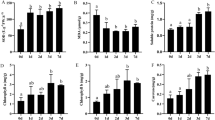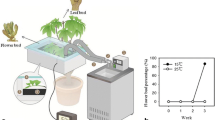Abstract
Cardiocrinum cathayanum (Endl.) Lindl. (Liliaceae) is a promising species for ornamental and pharmaceutical usage. However, genomic responses of C. cathayanum to temperature have not been investigated. In the present study, C. cathayanum leaves were cultivated at 10, 20, and 30°C, and leaves were collected for transcriptome sequencing. Overall, 36.9 to 44.1 M clean reads were obtained, which finally assembled 48 120 unigenes. Among these unigenes, 49.39% could be annotated to at least one public database. Compared with 20°C treatment, 381 and 303 unigenes were significantly upregulated, 580 and 1399 were significantly downregulated in 10 and 30°C treatments, respectively. Real-time qPCR analyses on selected 12 unigenes showed similar tendencies to those calculated on transcriptome sequencing. Compared with 20°C treatment, exposure to 10°C significantly affected the pentose and glucuronate interconversions, starch and sucrose metabolism pathways. Further exploration suggested that D-galacturonate and trehalose were accumulated at 10°C, which would enhance the tolerance to cold stress. Besides, 10°C treatment inhibited the biosynthesis of unsaturated fatty acids and α-linolenic acid metabolism. These changes might negatively affect C. cathayanum growth. At 30°C, 40 of 42 differentially expressed genes (DEGs) in the starch and sucrose metabolism, all the 27 DEGs in the glycolysis/gluconeogenesis and all the 17 DEGs in the fructose and mannose metabolism were significantly downregulated, in comparison to 20°C treatment. These changes demonstrated that high temperature greatly inhibited carbohydrate metabolism in C. cathayanum leaves. Overall, the present study contributed new insights to understand the genomic responses of C. cathayanum leaves to various temperatures.







Similar content being viewed by others
REFERENCES
Li, M., Ling, K.H., Shaw, P.C., Cheng, L., Techen, N., Khan, L.A., Chang, Y.S., and But, P.P., Cardiocrinum seeds as a replacement for Aristolochia fruits in treating cough, J. Ethnopharmacol., 2010, vol. 130, p. 429.
Lu, R.S., Li, P., and Qiu, Y.X., The complete chloroplast genomes of three Cardiocrinum (Liliaceae) species: comparative genomic and phylogenetic analyses, Front. Plant Sci., 2016, vol. 7, p. 2054.
Masashi, O., Tadashi, N., Tomoko, Y., Tarou, O., Junzo, M., and Shoichi, K., Life-history monographs of Japanese plants. 7. Cardiocrinum cordatum (Thunb.) Makino (Liliaceae), Plant Spec. Biol., 2006, vol. 21, p. 201.
Phartyal, S.S., Baskin, C.C., and Baskin, J.M., Seed dormancy and germination in the giant Himalayan lily (Cardiocrinum giganteum var. giganteum): an assessment of its potential for naturalization in northern Japan, Ecol. Res., 2012, vol. 27, p. 677.
Zhou, Z.G., Research on breeding technology and seed dispersal ability of Cardiocrinum cathayanum, Dissertation, Nanjing: Nanjing For. Univ., 2015.
Wang, X.F., Zhou, Z.G., and Wang, L., Relationship between bulb sizes and basal leaves' growth rhythm of Cardiocrinum cathayanum,J. Northeast For. Univ., 2014, vol. 42, p. 80.
Zhang, J., Long, Y., and Sun, G., Biodiversity of Cardiocr-inum giganteum and observation during its introduction, Acta Hortic. Sin., 2002, vol. 29, p. 462.
Niedziela, C.E., Kim, S.H., Nelson, P.V., and Hertogh, A.A.D., Effects of N-P-K deficiency and temperature regime on the growth and development of Lilium- longiflorum 'Nellie White’ during bulb production under phytotron conditions, Sci. Hortic., 2008, vol. 116, p. 430.
Ge, T., Wei, X., Razavi, B.S., Zhu, Z., Hu, Y., Kuzyakov, Y., Jones, D.L., and Wu, J., Stability and dynamics of enzyme activity patterns in the rice rhizosphere: effects of plant growth and temperature, Soil Biol. Bioche-m., 2017, vol. 113, p. 108.
Biradar, G., Laxman, R., Namratha, M.R., Thippeswamy, M., Shivashankara, K.S., Roy, T.K., and Sadashiva, A.T., Induction temperature enhances antioxidant enzyme activity and osmoprotectants in tomato, Int. J. Curr. Microbiol. Appl. Sci., 2019, vol. 8, p. 1284.
Shan, C. and Zhao, X., Lanthanum delays the senescence of Lilium longiflorum cut flowers by improving antioxidant defense system and water retaining capacity, Sci. Hortic., 2015, vol. 197, p. 516.
Wang, N., Bai, J.Q., Dong, P.B., Zhang, T.T., Wang, R.N., Wang, J.X., Liu, H.Y., Liang, R.Y., Tuo, P.P., Jing, X.T., and Wang, X.J., Characterization of the complete plastid genome of Cardiocrinum cathayanum, an endemic medicinal plant in China, Mitochondrial DNA, Part B., 2019, vol. 4, p. 1294.
Gong, X., Yan, B., Hu, J., Yang, C.P., Li, Y.J., Liu, J.P., and Liao, W.B., Transcriptome profiling of rubber tree (Hevea brasiliensis) discovers candidate regulators of the cold stress response, Genes Genom., 2018, vol. 40, p. 1181.
Li, S., Yang, Y., Zhang, Q., Liu, N., Xu, Q., and Hu, L., Differential physiological and metabolic response to low temperature in two zoysiagrass genotypes native to high and low latitude, PLoS One, 2018, vol. 13: e0198885.
Klimov, S.V., Astakhova, N.V., Bocharova, M.A., and Trunova, T.I., Low-temperature tolerance of photosynthesis and carbohydrate metabolic patterns account for the difference in tomato and cucumber cold tolerance, Russ. J. Plant Physiol., 1996, vol. 43, p. 783.
Sicher, R., Carbon partitioning and the impact of starch deficiency on the initial response of Arabidopsis to chilling temperatures, Plant Sci., 2011, vol. 181, p. 167.
Xu, J., Zhao, Y., Zhang, X., Zhang, L., Hou, Y., and Dong, W., Transcriptome analysis and ultrastructure observation reveal that hawthorn fruit softening is due to cellulose/hemicellulose degradation, Front. Plant Sci., 2016, vol. 7, p. 1524.
Fathi, B., Maghsoudlou, Y., and Ghorbani, M., and Khomeiri, M., Effect of pH, temperature and time of acidic extraction on the yield and characterization of pectin obtained from pumpkin waste, J. Neurosci. Res., 2013, vol. 44, p. 586.
Agius, F., Gonzalez-Lamothe, R., Caballero, J.L., Munoz-Blanco, J., Botella, M.A., and Valpuesta, V., Engineering increased vitamin C levels in plants by overexpression of a D-galacturonic acid reductase, Nat. Biotechnol., 2003, vol. 21, p. 177.
Cai, X., Zhang, C., Ye, J., Hu, T., Ye, Z., Li, H., and Zhang, Y., Ectopic expression of FaGalUR leads to ascorbate accumulation with enhanced oxidative stress, cold, and salt tolerance in tomato, Plant Growth Regul., 2014, vol. 76, p. 187.
De-Araujo, P.S., The role of trehalose in cell stress, Braz. J. Med. Biol. Res., 1996, vol. 29, p. 873.
Sun, Z., Zhang, W., Qu, S., and Ma, X., Studies on the fatty acids composition of the citrus cell membrane and its relationship with the cold resistance, J. Wuhan Bot. Res., 1990, vol. 8, p. 79.
Shahandashti, S.S.K., Amiri, R.M., Zeinali, H., and Ramezanpour, S.S., Change in membrane fatty acid compositions and cold-induced responses in chickpea, Mol. Biol. Rep., 2013, vol. 40, p. 893.
Chen, L.J., Xiang, H.Z., Miao, Y., Zhang, L., Guo, Z.F., Zhao, X.H., Lin, J.W., and Li, T.L., An overview of cold resistance in plants, J. Agron. Crop Sci., 2014, vol. 200, p. 237.
Xie, D.W., Wang, X.N., Fu, L.S., Sun, J., Guan, T., and Li, Z., Effects of low temperature stress on membrane fatty acid in tillering node of winter wheat, J. Triticeae Crops, 2013, vol. 33, p. 746.
Dai, Y.H., Liu, X.Y., and Meng, Q.W., Changes of photoinhibition and fatty acid composition in thylakoid membrane of cucumber leaves during low temperature and weak light stress and the course of recovery, Plant Physiol. Commun., 2004, vol. 40, p. 14.
Pedranzani, H., Sierra-de-Grado, R., Vigliocco, A., Miersch, O., and Abdala, G., Cold and water stresses produce changes in endogenous jasmonates in two populations of Pinus pinaster Ait, Plant Growth Regul., 2007, vol. 52, p. 111.
Savchenko, T. and Dehesh, K., Drought stress modulates oxylipin signature by eliciting 12-opda as a potent regulator of stomatal aperture, Plant Signal. Behav., 2014, vol. 9: e28304.
Bonnett, G.D., Hewitt, M.L., and Glassop, D., Effects of high temperature on the growth and composition of sugarcane internodes, Aust. J. Agric. Res., 2006, vol. 57, p. 1087.
Chaitanya, K.V., Sundar, D., and Reddy, A.R., Mulberry leaf metabolism under high temperature stress, Biol. Plant., 2001, vol. 44, p. 379.
ACKNOWLEDGMENTS
We thank the Shenzhen GenProMetab Biotechnology Company for their commentary and the language corrections in the present manuscript.
Funding
This work was supported by the Natural Science Foundation of Educational Committee of Anhui Province (project no. KJ2016A682), the Key Project of Visiting and Studying Inland and Aboard Program for Young Scholars (project no. gxfxZD2016234), the Scientific Reseach Foundation of Huangshan University (project no. 2018xkjq013), and the Open Research Project of Anhui Simulation Design and Modern Manufacture Engineering Technology Research Center in Huangshan University (project no. SGCZXYB03).
Author information
Authors and Affiliations
Contributions
X. F. Wang and Z. B. Wan designed the experiments. Y. J. Ye, M. Y. Fan, L. Chen and T. Ma collected samples and performed the experiments. X. F. Wang and Z. B. Wan drafted the manuscript and all authors revised it.
Corresponding author
Ethics declarations
This article does not contain any studies involving animals or human participants as objects of research. The authors declare that they have no conflict of interest.
Additional information
Abbreviation: COG/KOG—cluster of orthologous groups of proteins database / clusters of orthologous groups for eukaryotic complete genomes; DEGs—differentially expressed genes; FDR—fault detection rate; GO – Gene ontology; JA—jasmonates; KEGG—Kyoto encyclopedia of genes and genomes; log2FC—log2 fold change; Nr—non-redundant protein; RH— relative humidity; RIN—RNA integrity number; RPKM— reads per kilobase of exon per million reads mapped; 12-OPDA—12-oxo-phytodienoic acid.
Supplementary material
Rights and permissions
About this article
Cite this article
Wang, X.F., Ye, Y.J., Fan, M.Y. et al. Effects of Temperature on Transcriptome Profiles in Cardiocrinum cathayanum Leaves. Russ J Plant Physiol 67, 1105–1115 (2020). https://doi.org/10.1134/S1021443720060199
Received:
Revised:
Accepted:
Published:
Issue Date:
DOI: https://doi.org/10.1134/S1021443720060199




